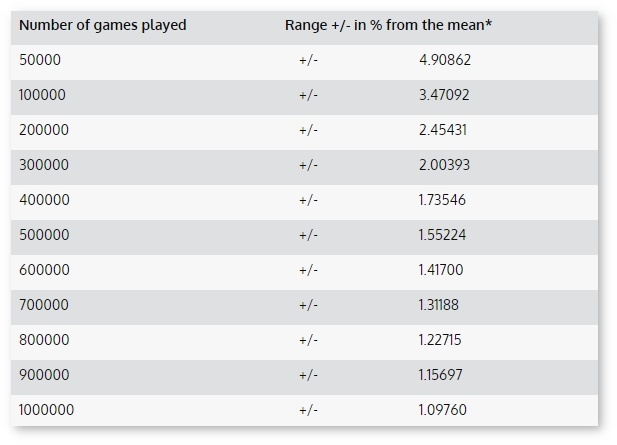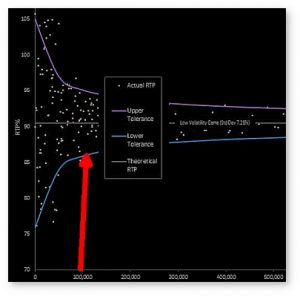What is the difference between RTP and variance… Does it matter?
For those who understand some of the inner workings of casino slots, the RTP of any given game can be a weighty influence on the decision to play or not. Some people look more at the volatility or inherent risk of a game when deciding. And of course, we all simply have favorite themes and titles that have tickled our excitement buttons in the past.
In this article, we’ll examine what the terms really mean, how they affect gaming satisfaction, and we’ll make a case for focusing more on volatility than RTP if you want to exert more control over the whether you ever win big or not.

RTP (Return to Player) is a theoretical and actual mathematical measure of the amount of money any given slot machine should and does pay back over time.
In the simplest terms, if the house edge is 5%, then the RTP is 95%. On average, after hundreds of thousands of spins, $0.95 of each $1.00 churned through the machine will be returned to players and $0.05 will be ‘left in the machine’. This is the casino’s profit margin.
Volatility is a measure of risk. A highly volatile game will have a long series of low paying, or zero return spins followed by random bigger wins. A game with a low volatility index will return money to the player more often but in smaller amounts.
While it may seem that unraveling the mysteries behind slots could take some of the fun and excitement out of them, the reverse is actually more likely. If you know how to choose a high RTP game with a volatility index that fits your play style, you can choose to spin all day on a small deposit or go for the gusto in an all-or-nothing frenzy in hopes of a big payday. That seems more fun than leaving your session up to the fates, doesn’t it?
Pro Tip – Random Jackpots:
If you know a game with an unusually big random jackpot has high RTP and low volatility, and the same chance to trigger on every spin, you will want to play that game because you can cycle your bankroll through it many more times than you could a riskier game with lower returns.
In order to more thoroughly understand slots and how the maths affect you, it is necessary to understand a few key terms. We won’t use them all in this article but they are all important to the discussion.
Key Terms RTP vs Standard Deviation/Volatility/Variance
Theoretical return to player percentage (RTP) – The amount of money a slot machine is expected to pay back over time.
Actual RTP – The amount of money a slot machine actually pays back over time.
Confidence Interval – If the testers use a 95% confidence interval the actual RTP will be within the accepted range (standard deviation) in 19 out of 20 tests. If the confidence interval is 99% only one out of one-hundred tests will fall outside the mean.
Volatility [standard deviation (SD), risk] – The standard deviation is the most commonly used index of volatility. Highly volatile games will present rare but large prizes, whereas a low volatility game will award smaller prizes, but they will occur more often. Highly volatile slots are less predictable.
Variance – This is not the same as volatility, but is often used interchangeably by laymen. The SD is arrived at as the square root of variance – variance depends on the cycle and prize frequency of a game.
Probability – The likelihood of an event occurring, or the total number of possible outcomes.
Permutations – As related to variance, a way in which a set of things or a number of things can be ordered or arranged.
Combinations – Random elements in any order. There are 120 possible ways to arrange five items if no results occur more than once. 5 × 4 × 3 × 2 × 1 = 120.
Random Number Generator (RNG) – a construct designed to generate a random set of numbers with no distinguishable patterns in appearance or generation. The math machine (algorithm) that assures a fair game
Game Maths – The programming of a slot to achieve the desired RTP, factoring in such things as bonus mechanics, hit frequency, bonus frequency, and how much of the RTP occurs during base gameplay or bonus rounds, etc.
Bonus Mechanics – How features are played out. This can also include how wild symbols appear and how they “act” (expanding, stacked, etc), respin features, free spins with multipliers, picking games, etc.
Game Engine – The software framework that does everything from rendering graphics and sounds, to managing features
Hit Frequency – How often the game will stop on any winning combination
Readers will find dozens or even hundreds of pages out there that talk about return to player  percentages (Theoretical RTP and Actual RTP) as well as volatility. Some are well-informed and some are full of gobble-dee-gook insisting that with the proper knowledge you can outguess a random number generator (RNG) and “win at slots”.
percentages (Theoretical RTP and Actual RTP) as well as volatility. Some are well-informed and some are full of gobble-dee-gook insisting that with the proper knowledge you can outguess a random number generator (RNG) and “win at slots”.
If you know all you want to know for now, or want to save a few brain cells to play, there actually are some “slot hacks” that can help you win.
Plenty of facts to follow…
We’ll break down these two important elements of slots play and sprinkle in enough hard science to make the subject understood and hopefully enjoyable for readers at all current levels of understanding.
Most players have a mixed bag of beliefs and feelings about slots, many have conflicting ideas. It’s okay to mix in a little superstition and magical thinking to make the games more fun as long the facts can stand on their own.
Are you still with me?
The reason the facts are not more widely understood in detail is rather easy to guess…
The study of probability is simply boring or cumbersome for many people. We’ve also been exposed to fairy tales and misunderstandings, not to mention outright scammers looking to make a buck off their “insider knowledge” of how slots work.
The simple fact that you are reading this tells us that you and I are almost on the same page, we both want to know presicely what goes on behind the curtain, and by the gods Fortuna, Bonus Eventus, and Tyche we want to know why we win and why we lose!
Jump to the meaty stuff or enjoy the minutia…
It would appear as if the physical model of virtual reel strips and the mapping of them to determine  game maths is most likely a defunct art of old-timers. Most of today’s slots seem to operate from another model, one where the result is determined and then the symbols on the reels align to the stars after the fact.
game maths is most likely a defunct art of old-timers. Most of today’s slots seem to operate from another model, one where the result is determined and then the symbols on the reels align to the stars after the fact.
Of course, most virtual reel machines are programmed like this but many slots today do not seem to have virtual reel strips.
We can only assume this is due to the complicated maths needed to code and deliver some of today’s advanced bonus mechanics. NetEnt comes to mind as do some of the newer Microgaming titles. We simply can’t be sure without access to the proprietary information.
What we do know for sure, because they tell us, is that some game developers are using fixed odds models rather than reel strip maths on games that appear to be slots, but in fact, simply spin animated reels for eye candy with the results determined otherwise.
One such game is Legend of Terra by NeoGames. Reading the Help file we find:
“The game’s appearance and functionalities are those of a slot. But the outcome of the game is actually determined by a fixed-odds paytable”.
Another UKGC-licensed developer also provides “slot” games based on the fixed-odds model of scratch cards. This removes all volatility for the operator because if a game is set to 97% RTP, exactly 97,000 game/pay instances in 100,000 will be equal bet winners. The operator is guaranteed a 3% house edge once every “ticket” has been cycled through.
The problem for players with this accepted and licensed model is that we do not know if the top  prizes have already been awarded (much like buying scratch tickets from a retailer) so we will never have a chance to win the top prizes if they have already been awarded. We may spin our wheels with empty tickets and the occasional small win – why? If the top prizes have already been awarded, they simply do not exist!
prizes have already been awarded (much like buying scratch tickets from a retailer) so we will never have a chance to win the top prizes if they have already been awarded. We may spin our wheels with empty tickets and the occasional small win – why? If the top prizes have already been awarded, they simply do not exist!
Real slots, in our opinion, do not operate like that. We believe that the old-style virtual simulation of a physical machine with x number of symbols on each reel, along with the attendant odds of that model, are the only pure and true slots.
The gaming commissions of the world may not agree. We find no rules or laws that dictate how the RTP is to be accomplished, only that it must be observable, verifiable, and repeatable.
The Meaty Stuff
Theoretical Return to Player Percentage vs Actual RTP
Before we go too deeply into the maths, it’s important to keep in mind that operators occasionally have options when it comes to RTP. The same game can have different maths at different casinos online just as they can and do on land.
How is this possible..?
The UK (RTS 3C) and Sweden, for example, require that the RTP be a knowable number for consumers. Many other jurisdictions do not require that you know the RTP. We occasionally see par sheets with a range of RTPs listed.
Glory be, guess what?
When the games are deployed in the UK where the RTP is stated in the rules they have the highest possible RTP setting. When they are offered elsewhere, under a Malta license, for example, they can be set to any number within the given range.
On the side of caution, we simply expect some Canadian slots to be less lucrative for players than the same titles at a UKGC licensed casino.
Does that seem unfair?
Read on to see why we’re not so sure…
Most developers keep their game data a closely held secret. Some are more generous with the information. You may see the RTP, a volatility index of low, medium, or high, the max bet possible (also adjustable by operators) and the maximum “exposure” of a single spin (the most that can be won). However, some casinos are proud to display at least the RTP if nothing else. We only know of one operator that actually allows players to filter games by volatility.
In reality, the volatility of a slot is a much more important consideration than the RTP (within a couple of percentage points either way).
Yes, that is counterintuitive, but we have to keep in mind that the theoretical RTP will only be reached (within more or less a percentage point) after ONE MILLION SPINS using a confidence interval of 95%. [Volatility (standard deviation) of 5.6].

As we can see from the table above captured from the UKGC website, there is a nearly 5% (4.90862) deviation from the mean after 50,000 spins! This tells us the RTP is more important to regulators and to a casino’s bottom line with thousands of players spinning than it is to individual players.
In more concrete terms…
A game with 94% Theoretical RTP can fairly give you or me an actual RTP anywhere between ~89.09% and ~98.9% after 50,000 spins and the Gambling Commission would still consider the game to be performing as expected.
That’s a big number, and if we do 1,000,000 spins we’re still only ahead or behind by a single percentage point (1.09760%).
Obviously, if given the choice, we would select the game with the highest RTP, but the number is simply too squishy to be the most important factor unless we consider the deviation.
Of course, a game with lower volatility would reach an acceptable deviation in fewer spins.

Let’s bring RTP home with volatility, shall we..?

Should you match your game choices to your appetite for risk?
Most likely!
RTP should matter most to you (within a few percentage points) if you play low-risk games and expect to spend the next 50-100 hours torturing your bankroll. Yes, life is one single gambling session but you have to break out the numbers somewhere for illustration.
50k spins@15 per minute = 55 hours. Please see the red arrow above. The very low-risk game (std dev 7.2%) begins operating near the theoretical RTP somewhere between 50,000 and 100,000 spins.
Spin 8 hours per day for 2 weeks to achieve going broke..?
If you normally want to spin all day or all night on a modest bankroll, in hopes of the rare jackpot  and you are happy with more frequent small wins (or win celebrations, depending on the software) then you may want to seek out low index games using a search engine and making a list of them.
and you are happy with more frequent small wins (or win celebrations, depending on the software) then you may want to seek out low index games using a search engine and making a list of them.
“Put it all on 17” and spin once..? Go broke or go home happy.
Alternately, if you prefer the adrenaline rush of a big win now and then, and you don’t mind busting your bankroll with a quickness most days, you know the sort of games to search for!
It can be very rewarding to hop around as well, depending on the mood du jour.
Choosing High-Risk Games
Before going further we’d like to caution that statistically, high-risk bettors lose more and lose more often. In the summer of 2019, regulators in Macau put a stop to casinos using artificial intelligence algorithms, facial identification, and other tech to identify and target high-risk players. According to Bloomberg, high-risk players tend to lose ten times more than the average player.
That said, playing highly volatile slots is the only way you are likely to win any significant amount of money. Yes, low-risk games do occasionally pay out well, but even the top prize is often small compared to what can be won on higher risk (high volatility) games.
Highly volatile slots, by nature, have a lower hit frequency. The wins are also bigger when they occur. A rule of thumb to follow when attempting to identify high volatility games by looking at the paytable is that the lowest possible prize is usually higher on a high-risk game compared to a low-risk game. However, the reverse is not necessarily true.
Player-Controlled Volatility
While you can increase the volatility of some games, you can almost never decrease it. Yes, there are free spins bonus rounds that give you a range of choices – more free spins with a lower multiplier or fewer free games with a higher multiplier.
And, of course, there is Good Girl Bad Girl from Betsoft. Choose the Good Girl for pays from left to right (low index), the Bad Girl for pays right to left (high index) or choose both for medium volatility…
But you can’t dial down the game maths – they are chiseled in stone.
However, you can increase your risk and reward potentials by choosing fewer paylines and increasing your bet on each line. If you normally bet $0.01 per line on all 20 lines, you can choose 10 lines and bet $0.02 per line. You will have half the chances to win twice as much. You have easily changed the volatility of the game to feed a higher risk appetite.
If you normally bet $1.00 per spin you can choose 11 lines at $0.09 each for $.99 spins.
RTP and Volatility Summation
Regardless of what our guts tell us, or even what other experienced players may believe, the maths show us that RTP is far less important than the volatility of a slot game. That is not to say we should ignore the number, it’s still important to some degree, especially on games tested with a high confidence interval where the deviation is small.
The SD, or volatility index effects the results of games far more than the RTP does since we will probably never spin the same slot 50,000 times, let alone 1,000,000 times – and – the potential result of every spin is influenced more by the inherent risk built into the game than the theoretical RTP.
If you find the subject of RTP and Volatility interesting we can suggest further reading.
- Estimating the Ability of Gamblers to Detect Differences in the Payback Percentages of Reel Slot Machines: A Closer Look at the Slot Player Experience
Anthony F. Lucas
A. K. Singh - A Personal Guide to Electronic Slot Machines
John M. Pacyniak, Ph.D. - For the mathematically inclined, a discussion of Standard Deviation on the Wizard of Vegas forum.
- Top 10 Slots with the Highest RTP
